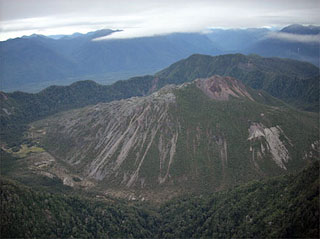Report on Chaiten (Chile) — 28 May-3 June 2008
Smithsonian Institution / US Geological Survey
Weekly Volcanic Activity Report, 28 May-3 June 2008
Managing Editor: Sally Sennert.
Please cite this report as:
Global Volcanism Program, 2008. Report on Chaiten (Chile) (Sennert, S, ed.). Weekly Volcanic Activity Report, 28 May-3 June 2008. Smithsonian Institution and US Geological Survey.
Chaiten
Chile
42.8349°S, 72.6514°W; summit elev. 1122 m
All times are local (unless otherwise noted)
Based on observations of satellite imagery, SIGMET reports, and pilot observations, the Buenos Aires VAAC reported that during 28 May-3 June continuous ash plumes from Chaitén rose to altitudes of 3-6.4 km (10,000-21,000 ft) a.s.l. and drifted N, NE, E, and SE. Cloudy conditions occasionally inhibited observations.
SERNAGEOMIN reported ash plumes that rose to altitudes of 3.5-4 km (11,200-13,100 ft) a.s.l. and drifted N, NNE, and W during 28 May-2 June. Beaches to the W and N (about 12 km away) continued to accumulate pumice up to 40 cm in diameter carried to the ocean by the Yelcho, Negro, and Chaitén rivers. On 28 May, the ash affected towns and caused airport closings hundreds of kilometers N. A dense layer of mist with suspended ash, about 1.5 km thick and continuous around the volcano on 31 May, resulted in poor visibility. An ash plume at an altitude of 4 km (13,100 ft) a.s.l. was observed above the layer on 30 May. The Alert level remained at Red.
Geological Summary. Chaitén is a small caldera (~3 km in diameter) located 10 km NE of the town of Chaitén on the Gulf of Corcovado. Multiple explosive eruptions throughout the Holocene have been identified. A rhyolitic obsidian lava dome occupies much of the caldera floor. Obsidian cobbles from this dome found in the Blanco River are the source of artifacts from archaeological sites along the Pacific coast as far as 400 km from the volcano to the N and S. The caldera is breached on the SW side by a river that drains to the bay of Chaitén. The first recorded eruption, beginning in 2008, produced major rhyolitic explosive activity and building a new dome and tephra cone on the older rhyolite dome.
Sources: Buenos Aires Volcanic Ash Advisory Center (VAAC), Servicio Nacional de Geología y Minería (SERNAGEOMIN)

